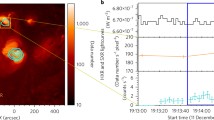Abstract
We present an analysis of the evolution of the thermal flare plasma during the 14 July 2000, 10 UT, Bastille Day flare event, using spacecraft data from Yohkoh/HXT, Yohkoh/SXT, GOES, and TRACE. The spatial structure of this double-ribbon flare consists of a curved arcade with some 100 post-flare loops which brighten up in a sequential manner from highly-sheared low-lying to less-sheared higher-lying bipolar loops. We reconstruct an instrument-combined, average differential emission measure distribution dEM(T)/dT that ranges from T=1 MK to 40 MK and peaks at T 0=10.9 MK. We find that the time profiles of the different instrument fluxes peak sequentially over 7 minutes with decreasing temperatures from T≈30 MK to 1 MK, indicating the systematic cooling of the flare plasma. From these temperature-dependent relative peak times t peak(T) we reconstruct the average plasma cooling function T(t) for loops observed near the flare peak time, and find that their temperature decrease is initially controlled by conductive cooling during the first 188 s, T(t)∼[1+(t/τcond)]−2/7, and then by radiative cooling during the next 592 s, T(t)∼[1−(t/τrad)]3/5. From the radiative cooling phase we infer an average electron density of n e=4.2×1011 cm−3, which implies a filling factor near 100% for the brightest observed 23 loops with diameters of ∼1.8 Mm that appear simultaneously over the flare peak time and are fully resolved with TRACE. We reproduce the time delays and fluxes of the observed time profiles near the flare peak self-consistently with a forward-fitting method of a fully analytical model. The total integrated thermal energy of this flare amounts to E thermal=2.6×1031 erg.
Similar content being viewed by others
References
Alexander, D. and Metcalf, T. R.: 1997, Astrophys. J. 489, 442.
Antiochos, S. K.: 1980, Astrophys. J. 241, 385.
Antiochos, S. K. and Sturrock, P. A.: 1978, Astrophys. J. 220, 1137.
Aschwanden, M. J., Bynum, R. M., Kosugi, T., Hudson, H. S., and Schwartz, R. A.: 1997, Astrophys. J. 487, 936.
Aschwanden, M. J., Tarbell, R. D., Nightingale, R. W. Schrijver, C. J., Title, A., Kankelborg, C. C., Martens, P., and Warren, H. P.: 2000, Astrophys. J. 535, 1047.
Cargill, P. J., Mariska, J. T., and Antiochos, S. K.: 1995, Astrophys. J. 439, 1034.
Carmichael, H.: 1964, in W. N. Hess (ed.), AAS-NASA Symposium on Solar Flares (NASA SP-50), p. 451.
Culhane, J. L. et al.: 1994, Solar Phys. 153, 307.
Feldman, U.: 1992, Phys. Scripta 46, 202.
Fisher, G. H. and Hawley, S. L.: 1990, Astrophys. J. 357, 243.
Freeland, S. L. and Handy, B. N. et al.: 1998, Solar Phys. 182, 497.
Handy, B. et al.: 1999, Solar Phys. 187, 229.
Kopp, R. A. and Pneuman, G. W.: 1976, Solar Phys. 50, 85.
Kosugi, T. et al.: 1991, Solar Phys. 136, 17.
Mariska, J. T., Emslie, A. G., and Li, P.: 1989, Astrophys. J. 341, 1067.
Masuda, S.: 1994, Hard X-Ray Sources and the Primary Energy Release Site in Solar Flares, Ph.D. Thesis, Natl. Astronomical Obs., Mitaka, Tokyo 181, Japan.
Masuda, S., Kosugi, T., and Hudson, H. S.: 2001, Solar Phys., this issue.
Meyer, J. P.: 1985, Astrophys. J. Suppl. 57, 173.
Rosner, R., Tucker, W. H., and Vaiana, G. S.: 1978, Astrophys. J. 220, 643.
Sakao, T., Kosugi, T., Masuda, S., Inda, M., Makishima, K., Canfield, R. C., Hudson, H. S., Metcalf, T. R., Wuelser, J.-P., Acton, L. W., and Ogawara, Y.: 1992, Publ. Astron. Soc. Japan 44, L83.
Schrijver, C. J., Title, A., and the TRACE Team: 2001, Solar Phys. 200,CD-ROM.
Sturrock, P. A.: 1966, Nature 211, 695.
Tsuneta, S.: 1996, Astrophys. J. 456, 840.
Tsuneta, S. et al.: 1991, Solar Phys. 136, 37.
Yan, Y., Deng, Y., Karlický, M., Fu, Q., Wang, S., and Liu, Y.: 2001, Astrophys. J. 551, L115.
Author information
Authors and Affiliations
Electronic supplementary material
Rights and permissions
About this article
Cite this article
Aschwanden, M.J., Alexander, D. Flare Plasma Cooling from 30 MK down to 1 MK modeled from Yohkoh, GOES, and TRACE observations during the Bastille Day Event (14 July 2000). Sol Phys 204, 91–120 (2001). https://doi.org/10.1023/A:1014257826116
Issue Date:
DOI: https://doi.org/10.1023/A:1014257826116




